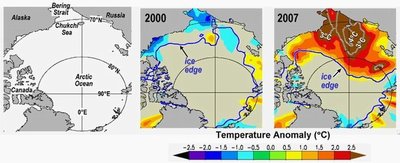December 11, 2007
Without its insulating ice cap, Arctic surface waters warm to as much as 5 C above average
Record-breaking amounts of ice-free water have deprived the Arctic of more of its natural “sunscreen” than ever in recent summers. The effect is so pronounced that sea surface temperatures rose to 5 C above average in one place this year, a high never before observed, says the oceanographer who has compiled the first-ever look at average sea surface temperatures for the region.
Such superwarming of surface waters can affect how thick ice grows back in the winter, as well as its ability to withstand melting the next summer, according to Michael Steele, an oceanographer with the University of Washington’s Applied Physics Laboratory. Indeed, since September, the end of summer in the Arctic, winter freeze-up in some areas is two months later than usual.
The extra ocean warming also might be contributing to some changes on land, such as previously unseen plant growth in the coastal Arctic tundra, if heat coming off the ocean during freeze-up is making its way over land, says Steele, who is speaking Wednesday at the American Geophysical Union meeting in San Francisco.
He is lead author of “Arctic Ocean surface warming trends over the past 100 years,” accepted for publication in AGU’s Geophysical Research Letters. Co-authors are physicist Wendy Ermold and research scientist Jinlun Zhang, both of the UW Applied Physics Laboratory. The work is funded by the National Science Foundation.
“Warming is particularly pronounced since 1995, and especially since 2000,” the authors write. The spot where waters were 5 C above average was in the region just north of the Chakchi Sea. The historical average temperature there is -1 C — remember that the salt in ocean water keeps it liquid at temperatures that would cause fresh water to freeze. This year water in that area warmed to 4 C, for a 5-degree change from the average.
That general area, the part of the ocean north of Alaska and Eastern Siberia that includes the Bering Strait and Chukchi Sea, experienced the greatest summer warming. Temperatures for that region were generally 3.5 C warmer than historical averages and 1.5 C warmer than the historical maximum.
Such widespread warming in those areas and elsewhere in the Arctic is probably the result of having increasing amounts of open water in the summer that readily absorb the sun’s rays, Steele says. Hard, white ice, on the other hand, can work as a kind of sunscreen for the waters below, reflecting rather than absorbing sunlight. The warming also may be partly caused by increasing amounts of warmer water coming from the Pacific Ocean, something scientists have noted in recent years.
The Arctic was primed for more open water since the early 1990s as the sea-ice cover has thinned, due to a warming atmosphere and more frequent strong winds sweeping ice out of the Arctic Ocean via Fram Strait into the Atlantic Ocean where the ice melts. The wind effect was particularly strong in the summer of 2007.
Now the situation could be self-perpetuating, Steele says. For example, he calculates that having more heat in surface waters in recent years means 23 to 30 inches less ice will grow in the winter than formed in 1965. Since sea ice typically grows about 80 inches in a winter, that is a significant fraction of ice that’s going missing, he says.
Then too, higher sea surface temperatures can delay the start of freeze-up because the extra heat must be discharged from the upper ocean before ice can form.
“The effect on net winter growth would probably be negligible for a delay of several weeks, but could be substantial for delays of several months,” the authors write.
###
For more information:
Steele, cell (206) 359-5130 while he’s attending AGU meeting Dec. 9 through afternoon of Dec. 14; after that, office (206) 543-6586, mas@apl.washington.edu

